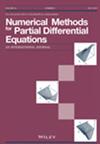稳态不可压缩磁流体动力学方程的两级稳定有限体积法
IF 1.7
3区 数学
Q1 MATHEMATICS, APPLIED
引用次数: 0
摘要
本文提出并分析了稳定不可压缩磁流体动力学方程的两级稳定有限体积法。利用线性多项式空间近似速度场、压力场和磁场,并引入两个局部高斯积分来克服离散inf - sup条件的限制。首先,利用browwer不动点定理证明了稳定有限体积法中离散问题解的存在唯一性;还给出了H2 $$ {H}^2 $$‐数值解的稳定性结果。其次,利用能量法构造相应的对偶问题,建立了H1 $$ {H}^1 $$和L2 $$ {L}^2 $$‐范数数值解的最优误差估计。第三,给出了稳定不可压缩MHD方程的两级稳定有限体积法的稳定性和收敛性。理论结果表明,当网格尺寸为h=本文章由计算机程序翻译,如有差异,请以英文原文为准。
Two‐level stabilized finite volume method for the stationary incompressible magnetohydrodynamic equations
In this paper, a two‐level stabilized finite volume method is developed and analyzed for the steady incompressible magnetohydrodynamic (MHD) equations. The linear polynomial space is used to approximate the velocity, pressure and magnetic fields, and two local Gauss integrations are introduced to overcome the restriction of discrete inf‐sup condition. Firstly, the existence and uniqueness of the solution of the discrete problem in the stabilized finite volume method are proved by using the Brouwer's fixed point theorem. H2$$ {H}^2 $$ ‐stability results of numerical solutions are also presented. Secondly, optimal error estimates of numerical solutions in H1$$ {H}^1 $$ and L2$$ {L}^2 $$ ‐norms are established by using the energy method and constructing the corresponding dual problem. Thirdly, the stability and convergence of two‐level stabilized finite volume method for the stationary incompressible MHD equations are provided. Theoretical findings show that the two‐level method has the same accuracy as the one‐level method with the mesh sizes h=𝒪(H2) . Finally, some numerical results are provided to identify with the established theoretical findings and show the performances of the considered numerical schemes.
求助全文
通过发布文献求助,成功后即可免费获取论文全文。
去求助
来源期刊
CiteScore
7.20
自引率
2.60%
发文量
81
审稿时长
9 months
期刊介绍:
An international journal that aims to cover research into the development and analysis of new methods for the numerical solution of partial differential equations, it is intended that it be readily readable by and directed to a broad spectrum of researchers into numerical methods for partial differential equations throughout science and engineering. The numerical methods and techniques themselves are emphasized rather than the specific applications. The Journal seeks to be interdisciplinary, while retaining the common thread of applied numerical analysis.

 求助内容:
求助内容: 应助结果提醒方式:
应助结果提醒方式:


